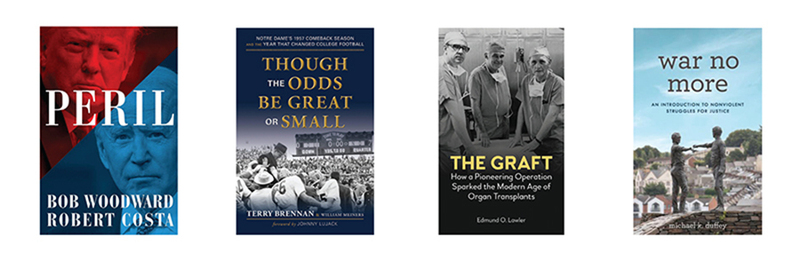
Peril, Bob Woodward and Robert Costa ’08 (Simon & Schuster). Legendary reporter Woodward collaborates with his Washington Post colleague Costa on an inside look at the tumultuous presidential transition from Donald Trump to Joe Biden. Drawing on 6,000 pages of transcripts from interviews with more than 200 people, the authors present eyewitness accounts of the 2020 election, the January 6 breach of the U.S. Capitol and the early days of the Biden administration as the new president confronted the health and economic challenges from the COVID-19 pandemic.
Though the Odds Be Great or Small: Notre Dame’s 1957 Comeback Season and the Year that Changed College Football, Terry Brennan ’49 and William Meiners (Loyola Press). Nineteen-point underdog Notre Dame ended Oklahoma’s 47-game winning streak on November 16, 1957, a high point in the tenure of Fighting Irish coach Terry Brennan, whose players carried him off the field after the victory. During that “comeback season,” Brennan’s team bounced back from a 2-8 record the previous year to finish 7-3 and rank No. 10 in the country, the third top-10 finish in his first four years as coach. Brennan died in September at age 93.
The Graft: How a Pioneering Operation Sparked the Modern Age of Organ Transplants, Edmund O. Lawler ’81M.A. (Anthem Press). Richard Lawler, the author’s great-uncle, led a team that performed the world’s first kidney transplant in 1950 — a procedure that sparked controversy on medical and religious grounds. The nuns who ran the Little Company of Mary Hospital in suburban Chicago supported the operation, and the debate over transplants largely faded into history as such surgeries became common. Edmund Lawler, a journalist and teacher, recounts a groundbreaking moment in medicine.
War No More: An Introduction to Nonviolent Struggles for Justice, Michael K. Duffey ’70, ’81Ph.D. (Rowman & Littlefield). Duffey, a Marquette University theologian who studies peace and social justice, examines 14 nonviolent movements — 11 that have succeeded and three that, so far, have not. Drawing on philosophical and religious texts as well as the thought of contemporary theorists and activists involved in peaceful resistance, Duffey outlines what makes nonviolence work. He contrasts the approach with military interventions in modern history to argue for the superiority of nonviolent solutions to conflict.